Morris & Fan. Reservoir Sedimentation Handbook
Подождите немного. Документ загружается.


FLUSHING 15.34
FIGURE 15.19 Use of dike to train the path of a flushing channel into the vicinity
of a service intake to maintain the intake area free of sediment. The dike would be
submerged during impounding.
where the sediment discharge Q
S
(t/s) is predicted from water discharge Q (m
3
/s) and
water surface slope S.
Based on field data during periods of empty flushing and retrogressive erosion in
Chinese reservoirs, the following empirical relationship was developed to describe the
rate of sediment release (Xai, 1983).
6.0
2.16.1
B
SQ
Q
s
(15.3)
The range of values for the dataset are given for each term: Q
S
= outflow sediment dis-
charge (range 0.0006 to 777 t/s), Q = water discharge (range 0.1 to 5730 m
3
/s), S = bed
or water surface slope (range 0.00006 to 0.016), and
Ε = erodibility coefficient. A high
value of
E corresponds to easily eroded sediment, whereas a low value of E corresponds
to deposits of coarse or consolidated sediment. A plot of field data and representative
values of
E are given in Fig. 15.20. Lai and Shen (1996) extended Curve III of this rela-
tionship to laboratory flume experiments using walnut shell grit as a sediment.
Field experience at a variety of sites indicates that peak suspended sediment con-
centrations exceeding 100 g/L should be anticipated for emptying and flushing when
sediment beds contain significant fines, but much smaller values may occur when only
coarse noncohesive sediment deposits are eroded. Zarn (1992) was able to accurately
predict the maximum sediment concentration of noncohesive sediment released from
deposits above Reichenau hydropower station in Switzerland using the one-dimensional
MORMO code, a research model.
In 1985 the Dashidaira Dam was built on the Kurobe River in Japan. This, the first
Japanese dam with large-scale flushing outlets in the bottom of the structure, was first
flushed in 1992. Both physical and numerical modeling was undertaken to predict the
flushing behavior at the dam, where it was planned to flush 600,000 m
3
of sediment over
9 days, producing suspended-solids concentration of 2800 ppm in the river below the
dam, not significantly higher than natural levels peaks during floods. However, sediment
was released more than twice as fast as predicted, suspended-solids levels reached 4400
ppm, and dark gray turbid water having an offensive odor reached the sea 36 km
ownstream of the dam. The odor was apparently caused by the accumulation and d
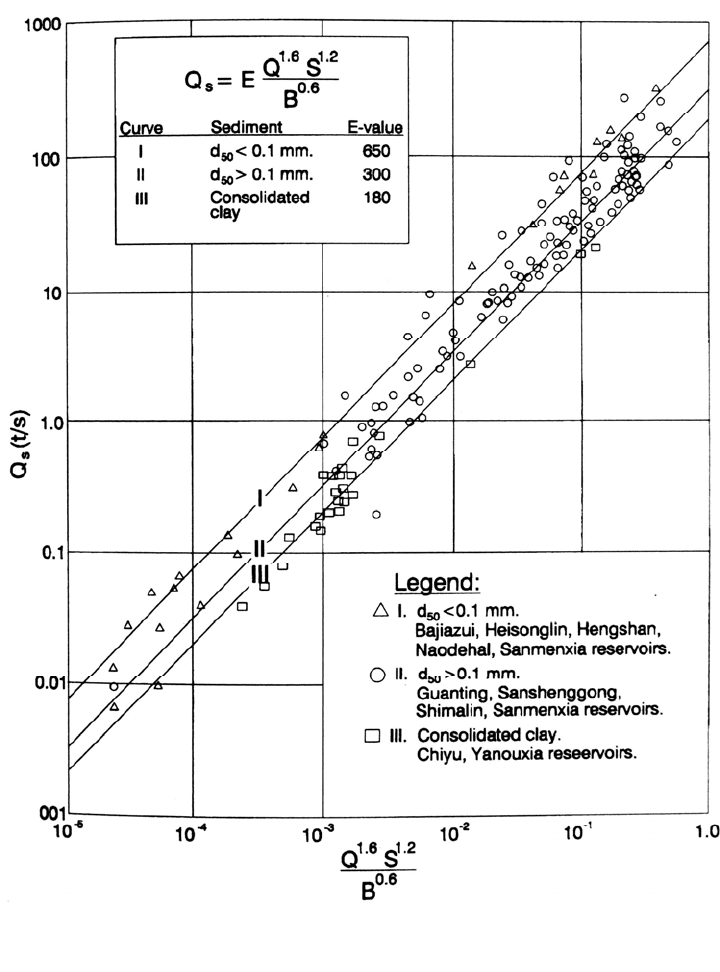
FLUSHING 15.35
FIGURE 15.20 Rate of sediment release during retrogressive erosion, based on empirical
data from Chinese reservoirs during emptying and flushing (Xai, 1983).
anaer
obic decomposition of organic material in the sediment. The flushing operation was
halted after 3 days.
The erosion of cohesive sediment was modeled by Bouchard (1995), who pointed out
that the sediment properties of noncohesive sediment are difficult to assess, and the
sliding of unstable banks can be an important phenomenon for supplying sediment to the
channels compared to erosion of the channel bed.
During maintenance flushing, the total quantity and peak concentration of sediment
released is determined by factors such as the amount and grain size of sediment that has
accumulated since the previous flushing event, flushing flow rate, drawdown procedure

FLUSHING 15.36
(i.e., release of turbidity currents during drawdown), and sediment consolidation. The
wide range in values that occur in practice are discussed in Sec. 15.6 and the Cachí case
study (Table 19.2). A sediment budget approach is necessary to estimate the volume of
sediment to be released during maintenance flushing.
15.13 LONG-TERM STORAGE CAPACITY
To estimate the volume of material that can be eroded by flushing and the volume that
can be maintained for long-term use, it is necessary to determine the geometry of the
main and, if present, the auxiliary flushing channels. This requires knowledge of: (1) the
channel planform layout across the deposits, (2) invert profile of each flushing channel
relative to the deposit geometry, and (3) the bottom width and side slope of each channel
to determine its volume.
In deposits of fine-grained sediment, the planform of the flushing channel will tend to
develop along the pre-impoundment river channel. However, in deposits of coarse
material the flushing channel can develop an actively meandering braided channel.
Stream planforms and the type of geometric control can change along the length of the
reservoir, moving from coarse delta deposits to deposits of fine sediment. The planform
location and length of auxiliary flushing channels will be established during their design.
Determination of channel slope and cross-section geometry will be complicated at
many sites by the complex configuration of the deposits, which will vary from the delta
to the dam and may include layered and cohesive material. Only approximate solutions
may be expected. Numerical modeling may be undertaken to analyze the probable con-
figuration of the flushing channel over time. Both FLUVIAL12 and GSTARS are one-
dimensional sediment transport models capable of adjusting channel width in accordance
with the concept of streampower minimization. They may represent useful tools to
analyze the development of flushing channel geometry in reservoirs, but the application
of these models for flushing studies has not yet been reported. The HEC-6 model requires
that the user specify the channel width beforehand. A number of one-dimensional models
have been developed in China, but they are essentially research tools and are not
available for distribution.
In China, the stream channel relationship developed by Altunin (1964) has been used
to estimate channel width:
2.0
5.0
5.1
S
Q
B
(15.4)
where B is channel bed width, m; Q is discharge, m
3
/s; and S is bed slope.
Tolouie (1993) examined the problem of defining the cross-sectional geometry of a
flushing channel at the Shahrud longitudinal diversion channel in Sefid-Rud Reservoir.
After comparing a variety of equations against field data, he developed the procedure
outlined below for estimating the size of a flushing channel. The description of the
Shahrud diversion channel in the Sefid-Rud case study (sec. 23.6) provides more infor-
mation on the site at which this analysis was developed.
The geometry of the flushing channel, or the volume of material that can be removed,
can be established if the following geometric channel properties are known: length, bank
profile, angle of repose, thalweg profile, and bottom width. The length is determined
from the thalweg distance or the layout of a pilot channel, and the bank profile will be
given by the elevation of the deposit surface. The angle of repose can be estimated or

FLUSHING 15.37
measured from the deposit geotechnical characteristics. This leaves two unknowns:
thalweg profile (slope) and bottom width.
The invert elevation at the downstream limit of the thalweg is determined by the
elevation of bottom outlets, or in the case of lateral or longitudinal erosion by the invert
of the main flushing channel at the terminus of the auxiliary channel. Initially the slope of
the flushing channel will follow the original stream, but this slope can be modified by the
accumulation of coarse material and the advancing face of delta deposits. The slope can
also be modified by sediment layering, and in the Shahrud channel Tolouie made separate
slope computations for the top cohesive layer and the final channel slope. The slope may
also be modified by topographic features buried beneath the sediment. With the slope
estimated from the site characteristics, the problem is reduced to the computation of
bottom width.
The following types of data are required to determine bottom width, and the numer-
ical values given are those used in the example computation.
S slope (0.0054)
Q discharge (8 m
3
/s)
ρ liquid density (1000 kg/m
3
)
Ps density of sediment grains (2650 kg/m
3
)
T age of deposit (25 years)
Ps, percent of silt and clay in deposit (50 percent)
g gravitational constant (9.81 m/s
2
)
1
p
plasticity index (not applicable to this sample; use 0)
Li liquidity index = water content/liquid limit (not applicable to this sample)
v kinematic viscosity (1.14×10
-6
m
2
/s at 15°C)
d
50
grain diameter (0.08 mm = 8×10
-5
m)
B bottom width, m
The first computational step is to determine the critical tractive force of the deposit,
which is the bed shear at which erosion is initiated. Two equations are proposed. For
noncohesive beds and for alternating beds of cohesive and noncohesive material:
(15.5)
c
0.052(
s
)gd
50
[1 (I
p
0.90
P
sc
0.84
log(9 T))]
Th
e first term is that of White (1940) and the second is based on field observations in the
Shahrud diversion channel. For the example condition this may be solved for T
c
= 2.8
N/m
2
.
c
0.052(2650 1000)(9.81)(8 10
5
)[1 0 50
0.84
log(34)] 2.8
N
m
2
In reservoir deposits, fines are often mixed with coarse sediments, imparting significant
cohesion to nominally cohesionless deposits. Thus, reservoir deposits tend to be more
erosion-resistant than pure sands. The second term in Eq. (15.5) accounts for this addi-
tional cohesion. To estimate the critical tractive force for layered sediment beds, use the
characteristics of the cohesionless sediment layer in the first term and the cohesive layer
characteristics for the second term. Tolouie notes that, in beds consisting entirely of
cohesive sediment, this equation probably underestimates the critical tractive stress (and
will thus overestimate bottom width).
For unconsolidated silt and clay deposits such as the weak, low density deposits
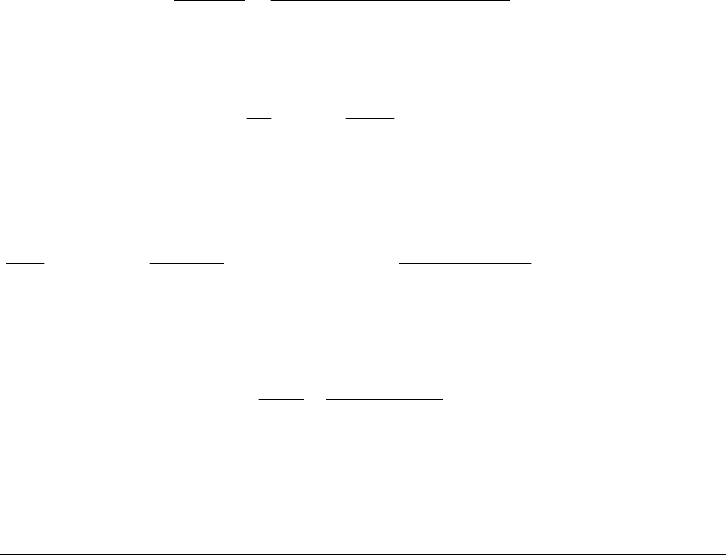
FLUSHING 15.38
encountered closer to the dim, the following equation may be applied:
(15.6)
5.0
25.1
)]9( [log4 TL
ic
Based on the work of Lane (1953), the shear stress acting on the sides of the channel
and causing it to widen may be estimated as 0.7 times the shear stress on the bottom.
Using this criterion, and having determined the critical shear stress in the previous step,
rearrange Eq. (9.16) to solve for flow depth at the critical condition:
c
D
c
S
gD
c
S
(9.16)
m
gS
D
c
c
076.0
)0054.0)(81.9)(1000)(7.0(
8.2
70.
(15.7)
Determine the critical shear velocity:
smU
c
C
/053.0
1000
8.2
2/1
2/1
*
(15.8)
The equation proposed by Keulegan (1938) was found to give an appropriate value for
the critical mean velocity V
c
:
7.2325.3
1014.1
)076.0)(053.0(
log75.525.3log75.5
6
*
*
v
DU
U
V
CC
C
c
(15.9)
From this we may compute V
C
= 1.25 m/s. From continuity Q = AV, and because the
section is wide and shallow A = BD. Combining gives
B
Q
V
c
D
c
8
(1.25)(0.076)
84m
(15.10)
These equations were developed and tested in the Sefid-Rud Reservoir and may not be
applicable at other sites.
15.14 CLOSURE
Sediment flushing has been performed regularly at a limited number of reservoirs and has
been well-documented at only a few sites. However, interest in this procedure is
increasing as reservoirs accumulate sediment and improved data are starting to become
available. Downstream impacts are large and effort needs to be directed toward mitiga-
tion of these impacts. This important topic has received much less study than flushing
procedures themselves. Also, at some reservoirs receiving a wide range of grain sizes,
flushing has successfully removed fines but coarse material continues to accumulate. This
underscores the need to consider the long-term accumulation of coarse materials as well
as fines in the implementation of flushing systems. While the general features of flushing
are well-known, there are no proven methods for computing many important parameters
relating to erosion rates, sediment concentrations, channel dimensions, sediment
focusing, and long-term storage capacity. These parameters can be predicted only
approximately. Modeling techniques for flushing processes are not well-developed, and
the behavior of coarse sediments in reservoirs which are flushed has received little
attention. There is considerable research opportunity in this area.
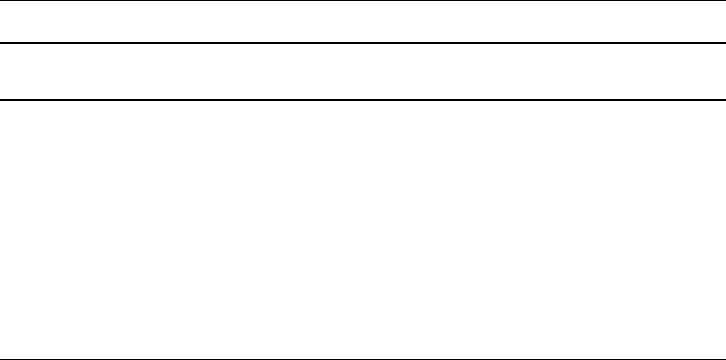
CHAPTER 16
SEDIMENT EXCAVATION AND DREDGING
16.1 INTRODUCTION
Sediment deposits may be mechanically removed from reservoirs by hydraulic dredging
or dry excavation. Selection of the excavation method will depend on factors including
sediment volume, grain size and geometry of the deposit, available disposal and reuse
options, water levels, and environmental criteria, all of which will affect the feasibility
and cost of alternative methods of excavation. All methods of mechanical excavation are
costly because of the large volumes of material involved and, frequently, the difficulty of
obtaining suitable sites for placement of the excavated material within an economic
distance of the impoundment. However, once sediments are deposited in a reservoir,
excavation is often the only management option available.
The removal of significant volumes of sediment from lakes or reservoirs
characteristically entails dredging, the lifting of sediment from the bottom to the surface
of a water body and deposition at another location. Most dredging is performed to
construct and maintain commercially navigable waterways. Dredging in the United States
amounts to about 500 Mm
3
/yr. The Corps of Engineers performs or contracts about 230
Mm
3
of dredging annually, of which about 90 percent consists of dredging in coastal
waters.
Dredging in lakes and reservoirs not used for commercial navigation has historically
been undertaken on a small scale, rarely involving more than 1 Mm
3
of sediment removal
per site. In smaller impoundments dredging has been focused on removal of silts and
organic sediments originating from accelerated erosion in the watershed and
eutrophication. The fine-grained and possibly organically enriched sediments contribute
to shallowing of the lake, impair fisheries, detract from recreational activities such as
bathing, and may continually recycle nutrients back into the water column thereby
sustaining high algae populations and aquatic weed growth even after external nutrient
inputs are reduced. In larger reservoirs dredging has focused on the cleaning of specific
areas such as hydropower intakes, navigational channels, and recreational areas. In some
cases dredging has been used to create or enlarge reservoirs, such as the water supply
reservoir for the City of Bradenton, Florida, which was enlarged by dredging sandy soils.
As sediment continues to accumulate in reservoirs, both the frequency and size of
reservoir dredging projects are increasing. At this writing the largest-scale reservoir
dredging project to our knowledge completed in the United States involved the removal
of 2.3 Mm
3
from Lake Springfield, Illinois, during the period 1986-1990, while the lake
was simultaneously used as a public water supply source for the City of Springfield. A
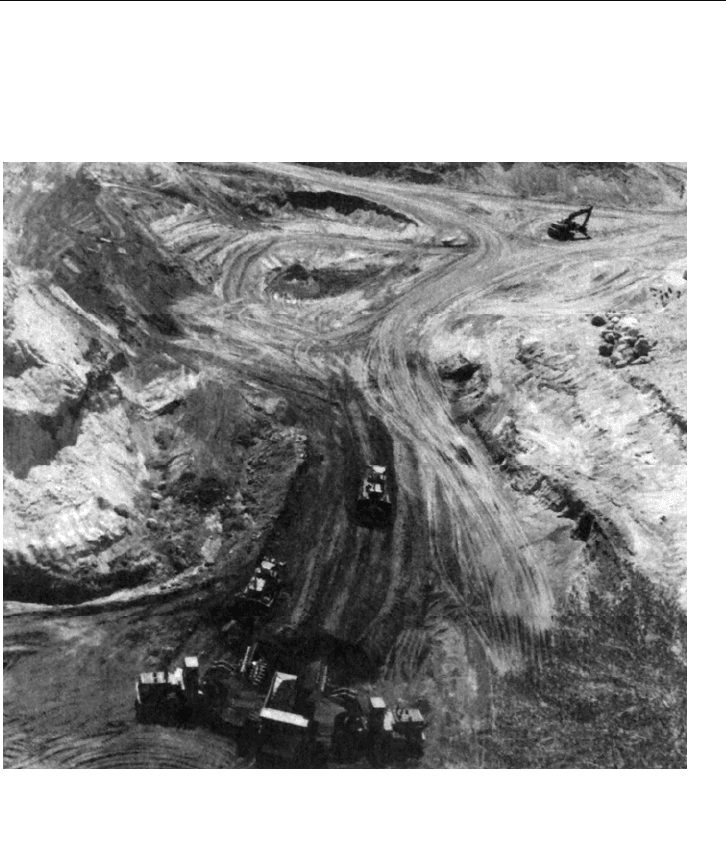
SEDIMENT EXCAVATION 16.2
contract for the removal of 6 Mm
3
from the Loíza water supply reservoir in Puerto Rico
was awarded in 1996.
This chapter describes sediment removal from reservoirs by both dry excavation and
dredging. More detailed information on dredging engineering is provided by Herbich
(1992), and Turner (1996) provides an overview of hydraulic dredging practice. The most
comprehensive information on containment area management is available from the
Dredging Research Program of the U.S. Army Engineer Experiment Station, P.O. Box
631, Vicksburg, Mississippi 39180. Cooke et al. (1993) discuss dredging and a wide
variety of other lake and reservoir management and restoration techniques. The Center
for Dredging Studies at Texas A&M University offers an annual dredging short course.
16.2 DRY EXCAVATION
Dry excavation is typically used for the cleanout of debris basins which are normally
empty and contain coarse sediments which dewater quickly. However, dry excavation by
conventional earth-moving equipment was also used to remove 2.3 Mm
3
of silt from
Cogswell Reservoir near Los Angeles, which was emptied for this purpose (Fig. 16.1).
FIGURE 16.1 Photograph of sediment removal at Cogswell Reservoir (courtesy Los Angeles
County).
SEDIMENT EXCAVATION 16.3
16.2.1 General Considerations
Several factors limit the use of dry excavation in reservoirs. Most important, it requires
that the reservoir be dewatered, limiting its use to impoundments which are seasonally
dry or which can be dewatered for a prolonged period. Conventional land equipment will
sink in thick deposits of inadequately dewatered fine sediment, and, depending on the
characteristics of the deposits, dewatering may require more than a year. Storm inflow
can inundate the work area. However, in reservoirs that are drawn down or emptied
annually, each year's accumulation of fine sediments may be desiccated and consolidated,
producing deposits that can be readily handled with conventional equipment. At Sefid-
Rud Reservoir (Chap. 23) the pilot channels for flushing were excavated across
seasonally dry sediment deposits by conventional equipment, 'although fine sediment
deposits near the dam were too soft for equipment access even after several years of
seasonal drawdown for flushing.
When a bottom outlet at the dam is opened to dewater sediment, the river flowing
across the deposits will scour the deposits, thereby producing downstream impacts
similar to emptying and flushing unless mitigation measures are implemented. Several
methods may be used to reduce downstream sediment release during excavation.
1. Initially perform only partial drawdown while excavating sediment from higher
elevations within the impoundment. The lowered pool will act as a sediment trap.
2. Construct sediment traps below the dam in areas which are readily accessible for
subsequent dewatering and cleanout.
3. Minimize the period of full drawdown, and time the initial full drawdown to coincide
with the dry season to minimize scouring of deposits and maximize the efficiency of
downstream sediment traps.
4. Close the lowest outlet and maintain a sediment-trapping pool above the dam during
periods of high inflow.
5. Divert dry season flows around or across sediment deposits with a lined channel or
temporary pipeline.
Dry excavation tends to be more costly than hydraulic dredging, but the comparative
economics will depend on the job characteristics. Excavation of dewatered sediment with
conventional equipment and trucks eliminates the problem of dewatering a dredge slurry,
reduces sediment bulking compared to hydraulic dredging, and can be used to deliver
sediment to many small and widely dispersed containment or reuse sites. Environmental
permitting requirements for dry excavation may also be simpler than for dredging. Unit
costs will vary widely, depending on the volume of material, haul distance, and elevation
difference between the points of excavation and disposal. Costs for debris basin
excavation are summarized in Table 16.1, and dry excavation costs at reservoirs are given
in Tables 16.4 and 3.3.
16.2.2 Cogswell Reservoir
The 11-Mm
3
Cogswell rockfill dam in Los Angeles was constructed in 1933 for flood
detention and water conservation. At this site, water conservation is practiced by slowly
releasing floodwaters to maximize groundwater recharge in the downstream riverbed.
During 1994-1996, 2.4 Mm3 of sediment, primarily silt, was excavated from Cogswell
Reservoir (Fig. 16.1). All the finer sediment in the main part of the reservoir was
removed, leaving behind only the coarse sediment deposited far upstream along
tributaries. The maximum haul distance was about 2 km, with a maximum uphill haul
(bottom of reservoir to top of fill) of 230m.
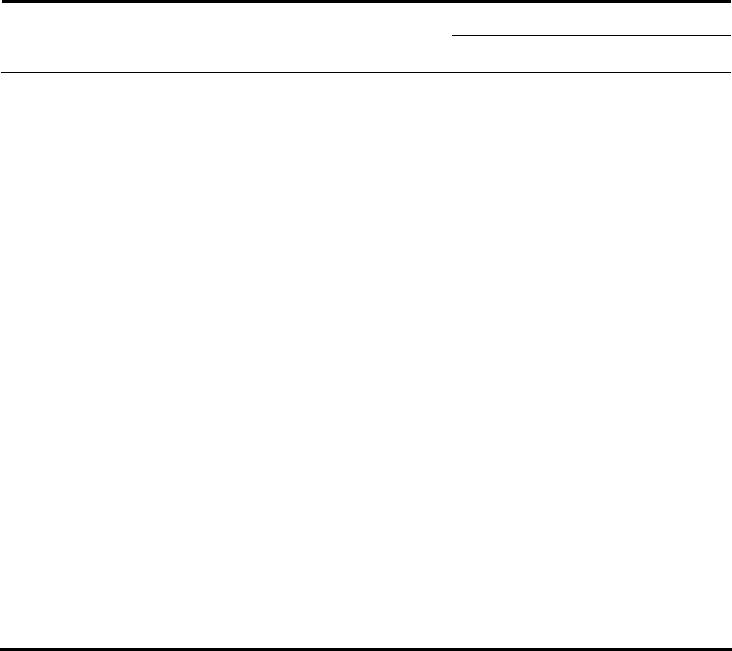
SEDIMENT EXCAVATION 16.4
TABLE 16.1 Cost of Sediment Removal from Debris Basins During 1993 in Los
Angeles County, California
Unit cost
Basin name
Volume
removed,
m
3
One-way
haul, km
$/m
3
$/yd
1 Dunsmuir 8,412 0.8 $5.23 $4.00
2 Halls 10,532 6.1 $7.41 $5.66
3 Gould 3,581 11.3 $7.83 $5.99
4 Kinneloa East 2,891 1.9 $8.65 $6.61
5 May No. 1 4,791 0.8 $9.39 $7.18
6 Las Flores 12,543 3.1 $9.52 $7.28
7 Brand 6,600 4.8 $10.00 $7.65
8 May No. 2 3,157 0.8 $10.52 $8.04
9 Wildwood 5,133 12.6 $11.10 $8.49
10 Blanchard 6,691 5.2 $11.66 $8.91
11 Aliso 14,876 11.3 $12.12 $9.27
12 Mullally 1,279 7.7 $13.29 $10.16
13 Devils M-1 DRI 11,846 4.8 $14.10 $10.78
14 Browns M-1 DRI 3,431 2.6 $14.86 $11.37
15 Deer 2,218 9.2 $15.32 $11.71
16 Kinneloa West 4,935 1.9 $17.22 $13.17
17 Lincoln 2,297 0.5 $17.41 $13.32
18 Turnbull 10,826 10.0 $19.75 $15.10
19 Sunset Upper 2,753 4.8 $22.38 $17.11
20 Vallecito 1,736 31.6 $23.04 $17.62
21 Hay 2,446 9.3 $24.09 $18.42
22 Linda Vista 369 13.2 $24.37 $18.63
23 Barkentine 1,032 10.1 $27.12 $20.74
24 Fieldbook 373 35.4 $29.70 $22.71
25 Oakmont View 134 6.0 $49.32 $37.71
Source: Courtesy Los Angeles County Dept. of Public Works.
Excavated material was placed in an adjacent canyon as engineered fill. The unit cost
for excavation and disposal was $5.60/m
3
. Engineering, environmental permitting, and
mitigation work cost about $2 million more (an additional $0.87/m
3
). Environmental
mitigation activities included revegetation of the fill, fish population studies downstream
of the reservoir, water quality and other monitoring costs, and sediment removal from
pools below the dam.
The project was designed to minimize the downstream release of sediment. To
minimize sediment release the reservoir was only partially drawn down during the first
years of excavation; full drawdown was timed to coincide with the dry season, and
sediment traps were dug within the reservoir area immediately upstream of the outlet and
below the dam. The trap upstream of the outlet was excavated in the deposits by heavy
equipment supported on the soft sediment by mats. Below the dam, in the area of the
plunge pool and at several sites within about 0.5 km below the dam, sediment traps were
constructed by building temporary instream barriers about 1 m tall using sandbags.
Because of these measures, only 5000 m
3
of sediment was deposited in pools beyond the
last instream sediment basin below the dam. Fine sediment that escaped downstream and
deposited in pools was subsequently suction-dredged by portable equipment.
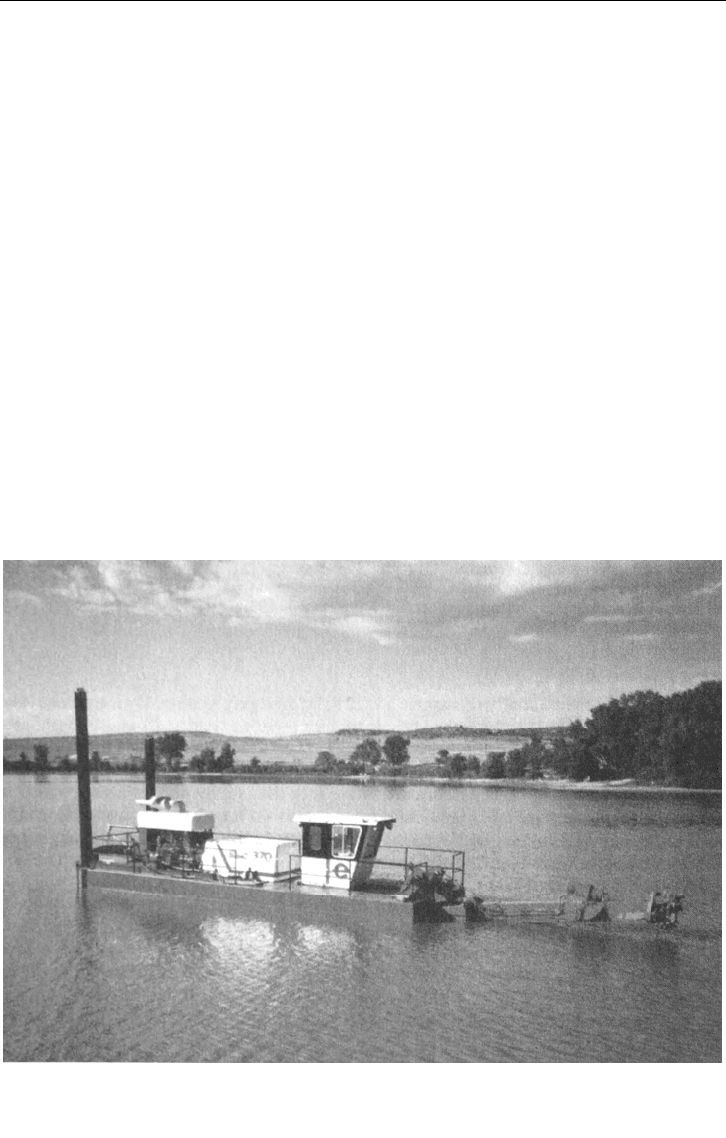
SEDIMENT EXCAVATION 16.5
16.3 TYPES OF DREDGES
Several types of dredging equipment can be used in reservoirs, and the siphon dredge has
been developed specifically for reservoir use. Dredging systems can be classified into
two broad categories: hydraulic and mechanical. In hydraulic dredging the sediment is
mixed with water and transported from the point of extraction to the point of placement
as a sediment-water slurry. Mechanical dredges use buckets to dig and lift sediment to the
surface with minimal water entrainment. Dredged material may be discharged into a
containment area or, in some countries, discharged to the river below the dam.
16.3.1 Hydraulic Suction Dredges
The hydraulic dredge with a rotating cutterhead at the end of the suction line is the most
widely used type of dredge in reservoirs (Fig. 16.2). Advantages of hydraulic dredges
include low unit cost for sediment removal, high rates of production, and ability to work
in a reservoir without interfering with normal impounding operation. A slurry pipeline is
a clean and convenient method to transport sediment from the dredging site to the
containment area. Hydraulic dredges are widely available and versatile, can pump long
distances with the aid of booster pump stations, and can efficiently handle material from
fine sediment through coarse sand. Larger material can also be dredged hydraulically, but
at higher unit costs because of the high pipeline velocities (and high friction losses)
required to maintain the material in suspension, plus increased wear on equipment. The
principal disadvantages of hydraulic dredging are the bulking of fine sediment and the
requirement for sediment dewatering.
FIGURE 16.2 Photograph of a 25-cm hydraulic dredge with the cutterhead raised (courtesy
E
llicott International).
